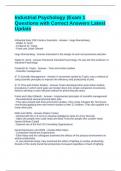Exam (elaborations)
Industrial Psychology (Exam 1 Questions with Correct Answers Latest Update
- Module
- Institution
Influential Early 20th Century Scientists - Answer-- Hugo Munsterberg - Walter D. Scott - Frederick W. Taylor - Frank and Lillian Gilbreth Hugo Munsterberg - Answer-Interested in the design of work and personnel selection Walter D. Scott - Answer-Pioneered Industrial Psychology. He was the...
[Show more]



